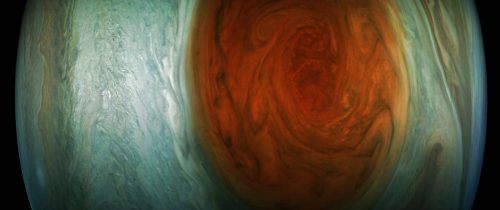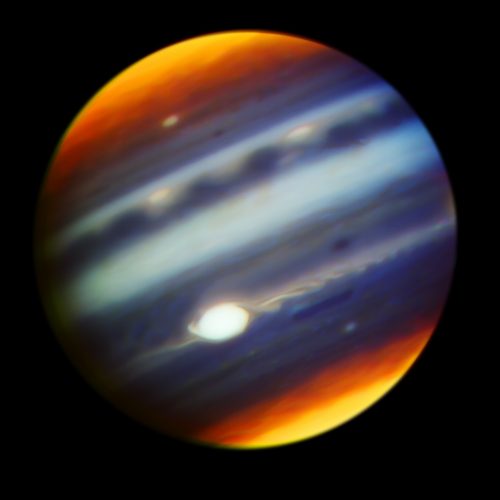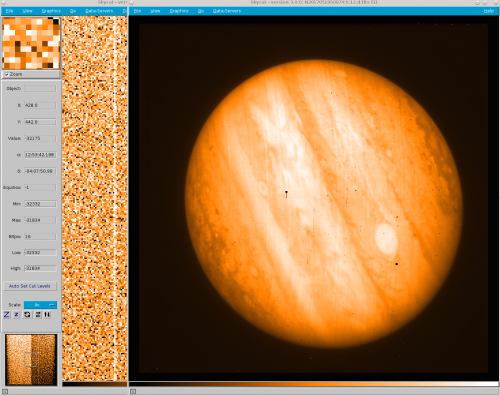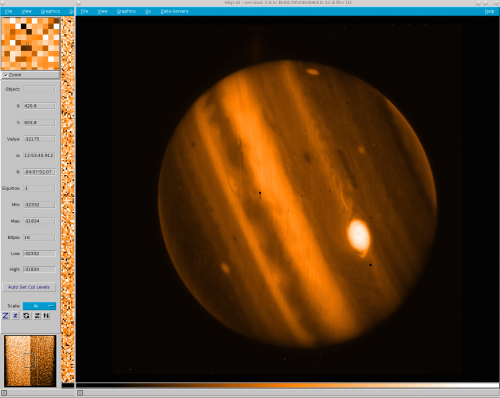- Date: 27 Jul 2017
- Comments: (0)
- Categories: For Astronomers, For Everyone, Images/Videos
Gemini Shoots Jupiter a Quick Look
NASAʻs Juno Spacecraft Mission
NASA’s Juno spacecraft has been in orbit around Jupiter a bit over a year, providing unprecedented views of the largest planet in our Solar System. Jupiter is named after the Roman deity that ruled over the Roman gods. In Roman mythology, Juno was Jupiter’s wife. It’s a fitting name for a NASA spacecraft that is designed to reveal the secrets of the giant planet. Juno’s suite of instruments are designed to probe how Jupiter formed and explore the planet’s internal structure and composition below the cloud tops and storms.
Juno is on an elliptical orbit that comes in very close to the planet and its intense radiated environment moving from pole to pole to study Jupiter’s internal structure, magnetic field, and composition. Every 53 days, the spacecraft repeats this swan dive with its instruments locked onto Jupiter. JunoCam, the outreach imager on the spacecraft, then beams stunning images back to Earth. With Juno’s orbit and JunoCam’s wide field-of- view, the mission is awarding us with never-before-seen views of the cloud tops and the polar regions. On July 10th, Juno zoomed across the giant red spot on Jupiter, snapping this image below.

Enhanced-color image of Jupiter’s Great Red Spot snapped by Juno and processed by citizen scientist Gerald Eichstädt.
Photo credit: NASA/JPL-Caltech/SwRI/MSSS/Gerald Eichstädt.
Gemini Points Juno Spacecraft Toward Discovery
In support of the mission, astronomers around the world have been organizing ground-based campaigns to monitor Jupiter before, during, and after Juno’s closest approaches to give wider context for Juno’s observations. Gemini images provide a high-resolution spatial context for some of the instrument suite observations. From the ground, it’s also possible to observe wavelengths and regions of the planet not available to Juno’s instruments. Glenn Orton, a co-investigator on the Juno mission at Caltech’s Jet Propulsion Laboratory (JPL), is leading a program using the Gemini North Telescope to do just this.
Combining the Altair natural guide star adaptive optics system with the Near Infra-Red Imager (NIRI) f/32 camera on the Gemini North telescope high atop Hawai‘i Island’s Maunakea, Gemini Observatory has been busy taking crisp full disk images of Jupiter. These images, made with multiple filters to look at the composition of the cloud tops, and different cloud bands across the planet, as well as at the longitudes on the gas giant, reveal what will be beneath Juno during its close encounters.

A multi-wavelength near infrared view of Jupiter combining data from Gemini Northʻs Altair and NIRI. Photo credit: Gemini Observatory/AURA/NSF/JPL-Caltech/NASA.
Taking a Quick Look at Jupiter
The Jupiter program has quickly become one of the favorite targets to observe for the Gemini North night crew because of the stunning views in the raw data previews coming from NIRI. So what do the Gemini North observers and operators who observe this program see? NIRI takes an image, writes the data to disk, which then pops up on the Gemini Observatory quick look tool. The quick look tool checks the observations taken in real time. The observers later do deeper checks using nighttime analysis scripts to view the raw data being taken on the telescope, but the quick look tool provides the first view of the science data. Most of the quick look views are not that interesting, maybe showing a star field or a bright line showing the collected spectrum, but with this Jupiter monitoring program, several of the quick look images are stunning.
Here are two screenshots taken a few months ago while observing Glenn’s Jupiter program. In this raw image of a single filter, the giant planet looks positively regal with its characteristic red spot ‘glowing’ in the scaling and color scheme of the quick look graphical user interface (GUI). Even in the raw data, the quick look view shows the complexity of Jupiter’s belts and storm systems.

A view of Jupiter from the Gemini North quick look tool. Image credit: Jen Miller/Gemini Observatory/AURA/NSF.

A view of Jupiter in a different near infrared filter from the Gemini North quick look tool. Image credit: Jen Miller/Gemini Observatory/AURA/NSF.
You can learn about and follow the Juno spacecraft mission on its website and learn more about Glennʻs observing program on our webpage.





